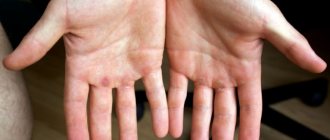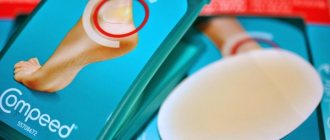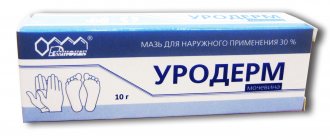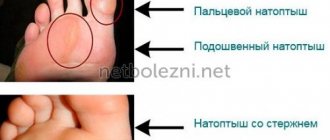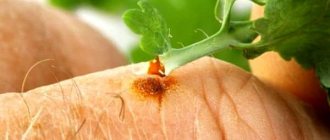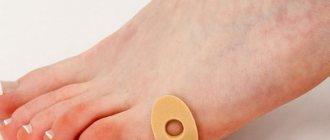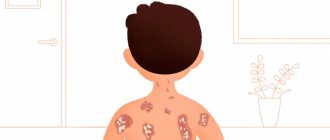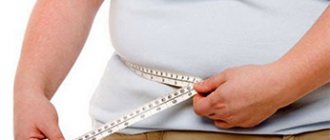Treatment of calluses and corns. Modern methods of therapy
Treatment of calluses is not the biggest problem of modern medicine.
But calluses cause inconvenience, and they just look ugly. Therefore, their competent removal determines the comfort of human life. Depending on the tissue structure, calluses are divided into:
- dry – normal roughening of the skin, without a cavity;
- aqueous - rubbed skin forms a cavity in which there is a colorless, watery, odorless liquid;
- blood - the same cavity, only with blood content;
- calluses with a core are the same dry calluses in which, due to constant irritation, a compaction has formed in the thickness of the tissue (core) in the same place.
Corns are diagnosed separately. The difference between them and calluses is that:
- they are usually smaller in size;
- “built” from a compacted center, around which there is a circular (circular) inflamed area of skin;
- painful even with slight pressure.
Removing corns, like calluses, is not a complicated procedure.
Symptoms
The main signs that a person may have or already have corns are:
- thickening of the skin;
- redness of the affected area;
- changes in the structure of the skin, the area becomes rougher;
- decreased sensitivity;
- the appearance of pain when walking;
- change in skin color, it becomes lighter, even yellowish.
Even before corns appear on the fingers, pathological changes in the skin in the form of swelling and slight redness can be detected.
It often happens that dry calluses appear suddenly, without symptoms. You can observe a thickening of the skin and a change in its structure, namely: it becomes rougher, without clear boundaries with a whitish or yellowish color.
Corns can be convex or flat in shape, with a rough or smooth surface. The patient may note that the skin of the affected area has become less sensitive to tactile and pain reactions.
In addition, when dry calluses appear, many people notice discomfort when walking due to the pressure of the body weight on the callus. Painful sensations may intensify during inflammation and infection, as well as when deeper cracks appear.
Anatomical and physiological essence of calluses
To successfully treat calluses, you need to understand why they occur.
The skin is designed in such a way that it is not afraid of external irritants (chemical, mechanical, thermal). And thanks to the regular proliferation of cells, it is able to quickly regenerate (old cells are rejected, new ones appear in their place).
But with prolonged mechanical action, friction, pressure, excessive irritation, the skin becomes rough and calluses appear. Most often they are formed due to permanent friction on the hands and feet. Although calluses are often observed on the elbows, tongue, gums and even in such unusual places as the male penis, labia in women, nipples and areas of skin under the nails.
More information about what atypical places calluses can form and what this means for the patient can be found on the pages of our website https://www.dobrobut.com/. Also on the site you will find other useful information about calluses and corns.
Causes of corns
A corn is a thickening of dead (dead) cells in the outer layer of skin (epidermis) that forms on the foot or sole of the foot. This formation is the result of mechanical action on a certain area of the skin, most often pressure or friction. In response to damage, the body turns on one of the mechanisms of defense against irritation: it increases the thickness of the skin in this place. Then the epidermal cells die, but due to the large number of layers, it is not removed on its own, but remains on the skin and turns into a source of discomfort.
To maintain the health and beauty of your feet and avoid the appearance of dry calluses in the future, you need to know the cause of their occurrence and take preventive measures.
The main factors that provoke keratinization of dead cells on the feet are:
- Tight and uncomfortable shoes (high heels);
- Excess weight;
- Incorrect sizes of shoes, socks or tights;
- Inconsistency between the shoe last and the anatomical structure of the foot (for example, a too narrow toe that squeezes the toes, or high heels and wedges).
- Frequent walking on rough surfaces barefoot;
- Injuries of the lower extremities, involving the formation of an abnormal gait and increased load on the extremities;
- Fungal skin lesions.
Previously, it was believed that corns could only appear in the fairer sex. Many men are also susceptible to the formation of such keratinized areas, which causes a lot of inconvenience and worsens a person’s quality of life.
Factors that provoke the formation of corns are associated with the physiological characteristics of the human body. These include:
- Poor circulation;
- Excessive sweating;
- Flat feet;
- Diseases of joints and bones.
Corns are an occupational disease for athletes, ballerinas and dancers, because... The main burden in this category of professions falls on the legs.
To avoid the formation of dry calluses, you should carefully monitor the hygiene of the lower extremities and select the correct shoes (by size). But if a corn has already formed, rest assured that it will not disappear on its own. It will have to be treated, but you can start with effective natural home remedies.
Treatment of calluses, basic methods
You can get rid of roughening (callus) of the skin in different ways. Treatment for calluses depends on their type and severity. In the arsenal of doctors are:
- therapy with medications that “dissolve” skin roughness;
- anti-callus patches;
- surgical removal (excision);
- The most modern method is laser removal of calluses.
Removing calluses using surgical instruments is performed not only by surgeons, but also by podiatrists - specialized specialists who deal exclusively with the feet.
Which doctor should I contact?
If corns appear, you should consult an orthopedist. In some cases, it takes some time to find out the root cause of the appearance of calluses (for example, get tested or visit additional specialists).
Therefore, to relieve pain, the doctor may temporarily prescribe:
- anti-callus patch;
- keratolytic cream.
In the most advanced cases, the doctor prescribes surgical removal of the corn.
During the operation, the surgeon desiccates only the damaged part of the tissue, removing the rod.
Treatment of dry calluses on toes and hands
If such calluses have appeared recently, they do not need to be excised. There is every chance that such calluses can be removed by using gels and creams with keratolytic properties - that is, those that prevent changes in skin cells, which causes its roughening.
Some of the most effective ingredients of these ointments and gels are:
- salicylic acid;
- benzoic acid.
Treatment of dry calluses on the toes (feet) and hands (palm of the hands) may take longer than in other locations. The reason is that the skin here becomes calloused more intensely and to a greater depth. To be more effective, the removal of dry calluses on the feet and hands should be preceded by softening them (achieved by simple immersion in liquid).
What is it: description and photo
Corns, or dry calluses, are compactions of the surface layer of the skin that occur in areas of increased production of epidermal cells. The accumulation and growth of skin compactions occurs as a result of damage to the skin and subcutaneous tissues.
Most often, changes in skin integrity are caused by compression resulting from improper distribution of load and mechanical irritation. Below is a photo of the disease.
Treatment of dry calluses with a rod
In this case, the surgical method is more effective, since it is technically impossible to lubricate the roughened core deep in the tissue with keratolytic ointments or gels in order to soften it.
Treatment of dry calluses with a core is a small surgical operation in compliance with the principles of asepsis, that is, with the treatment of the surgical field and the doctor’s gloves with antiseptics. Local anesthesia is mandatory, especially if the callus is old and it is assumed that the rod is deeply embedded.
Callus removal proceeds as follows:
- First, the callus itself is excised;
- Next, a neat incision is made in depth;
- Through it, the clamp grasps the rod and removes it.
It is easier to remove a callus on a toe with a rod than on the heel, because the length of the rod will not be long and the cut will not be deep.
Prevention
- The main way to prevent dry calluses is to wear comfortable shoes. You should choose soft shoes that fit in size and fit. It is better to give preference to models with a loose toe so as not to pinch your fingers.
- In addition, it is better to avoid wearing high-heeled or flat-soled shoes for long periods of time. It is better to leave it for a special occasion, such as going to a restaurant.
- Rubbing your fingers can cause them to sweat, so it is better to choose socks made from natural fabrics.
- In any shoe or orthopedic store you can buy lining made of soft materials that will reduce pressure on the feet. These pads are placed under the corns. In addition, pads that separate the toes are sold.
- From time to time you need to give your feet spa treatments in the form of baths, treating dry areas of the skin with pumice, applying nourishing and softening creams, and massaging your toes.
The formation of corns is a fairly common occurrence. Timely treatment allows you to cope with them even at home. And treatment of advanced stages should be trusted only to doctors who will prescribe a full examination and treatment.
Folk remedies
At home, you can combine pharmaceutical drugs and simple non-traditional recipes.
Local procedures are considered the most effective folk remedies in the treatment of cracks, corns and dry calluses. Each method - baths, compresses, lotions, masks - is based on the use of natural plant ingredients.
The best among them:
- Crassula or money tree;
- potato;
- onion;
- propolis;
- pine resin;
- dandelion;
- ivy;
- celandine;
- sap.
Natural ingredients are used fresh or dried. The raw materials are poured with boiled water and infused for about 20-30 minutes. After filtration, the finished infusions are used in appropriate recipes.
Lotions and compresses for corns
Homemade lotions, which consist of soaked onions in vinegar, are used every evening before going to bed until the problem disappears completely. First, your feet need to be steamed in a warm bath and treated with pumice after the procedure.
Recipe and use of lotion:
- 2-3 medium onions, previously peeled and chopped, are soaked in a glass of 9% table vinegar for 3-4 hours.
- The mixture is applied to problem areas, secured with a medical napkin and a sterile bandage.
- Put on socks and leave for up to 12 hours.
You can finely chop the onion, soak it in milk and lubricate the affected areas.
Propolis or pine resin are also used as compresses:
- Before use, any of the products is heated in a water bath to 37-38 degrees and applied to the affected feet using a silicone spatula.
- The legs are wrapped in cling film or plastic bags.
- Put woolen socks on top. The procedure time is 8-12 hours.
The duration of the course is until the corns disappear. Experts advise using raw eggs and a mixture of raw potatoes and natural honey. You need to keep such compresses for about 20-30 minutes every day for a month.
Foot baths
It is better to carry out restorative baths 2-3 times a day in warm or cool water.
Baths with whey or herbal infusions will help eliminate corns. Herbalists advise not to neglect salt procedures. To do this, dilute 1 tablespoon with a liter of cold water. As a result, pain is reduced, the skin softens and after 1-2 weeks, dry calluses disappear completely. The procedure time is 30 minutes. Instead of salt, you can use soda, sea salt, ammonia.
Pedicure socks
Corns on the feet - treatment, quick relief (photos will be posted later in the article) from painful calluses is carried out using convenient home methods - can be eliminated using pedicure socks. They are produced in the form of shoe covers made of transparent film. The active ingredient is lactic acid, and the socks are saturated with it.
The composition may also contain hyaluronic acid, castor oil, and soybean oil. Thanks to all these components, the effect of deep peeling and moisturizing of the skin of the feet is achieved. The process of removing corns with this product is quite long, but the result is comparable to a salon procedure. This procedure must be carried out at home according to the instructions.
The general rules are as follows:
- wash, steam and treat your feet with pumice stone;
- open the socks and pour the solution into them;
- carefully put on pedicure socks and another pair of cotton socks on top;
- keep the specified time;
- rinse off the residue with warm water.
The peeling action continues after rinsing. The process takes 5-7 days. At this time, the feet will not look very aesthetically pleasing, since the old skin will be actively replaced by new ones. Do not tear off the peeling skin so as not to damage the new one. In extreme cases, it can be cut off with nail scissors.
The result after such a deep peeling lasts for 3-4 months, then you can repeat this procedure as necessary.
Pads against corns: proper prevention is the best protection
Coping with a disease at an early stage is easier than when it is already advanced. But it’s even easier to prevent it from appearing. Constant prevention will help avoid the formation of dry calluses. To do this, you need to carefully consider the choice of shoes; women alternate stilettos and heels with ballet flats and moccasins. Apply moisturizer daily and have regular pedicures.
If you have to constantly wear high-heeled shoes, you need to use special silicone pads. They are designed for reusable use. It is recommended to wash the pads frequently with water and sprinkle with talcum powder before use. Their main purpose is to distribute weight evenly, which eases the load on the feet, thus protecting against the appearance of corns. They can be presented in the form of insoles, half-insoles and inserts. These types of pads differ in size. For closed shoes, you can choose insoles or semi-insoles, but inserts are suitable for open women's shoes or sandals. It is also worth considering where on the foot corns most often form. The inserts protect the skin under your toes; for a better effect, you can opt for the insole.
Author of the article:
Kuzmina Vera Valerievna |
Endocrinologist, nutritionist Education: Diploma of the Russian State Medical University named after. N.I. Pirogov, specialty “General Medicine” (2004). Residency at the Moscow State Medical and Dental University, diploma in Endocrinology (2006). Our authors
Compresses
Compresses and lotions are no less popular for removing corns:
- Lotions with aloe juice - apply a freshly cut aloe leaf to the corns overnight and secure it with an adhesive plaster. After waking up the next morning, you should carefully treat the problem area with pumice.
- Lemon lotions - before going to bed, you should steam your feet, then wipe them dry. At night, apply a piece of lemon with peel to the problem area. You need to repeat this action for 3-4 days. Then you need to steam your feet again and rub them with a pumice stone or a rough brush.
- Lotions with potatoes - you need to grate one potato on a fine grater. The resulting mass is wrapped in a piece of gauze and squeezed out a little. It should be applied to the sore spot at night. The next morning the skin will become pliable and the callus can be removed.
- Compress with onion - the peeled head is cut into half rings, then applied to the callus, a bag and a warm sock are put on top. The compress should be left until the morning. Then the skin is washed with warm water and the peeled skin is carefully removed with a pumice stone. After the procedure, it is recommended to moisturize the skin with cream.
- Compress with propolis – you need to soften the propolis, then apply it to the corns and wrap it with polyethylene. Put a warm sock over the bag. You need to wear the compress without removing it all day. Softened skin will be easy to remove after such a compress.
- Compress with celandine - the leaves of the plant need to be cleaned and ground in a blender. The resulting mixture is applied to the sore spot. Then wrap the foot in a plastic bag, put on a sock and leave it overnight. In the morning, wash your feet and rub problem areas with pumice. If the corns do not go away after the first application, you should repeat the procedure until they disappear completely.
Cryodestruction
Cryodestruction involves exposing a corn or callus to liquid nitrogen. At a temperature of -196 degrees, the keratinized tissue dies.
Advantages and disadvantages of this type of removal:
- Speed – the procedure lasts from 30 seconds to 2 minutes.
- Painlessness - the only thing you can feel during the procedure is a slight cold. No anesthesia is required.
- Cryodestruction can be performed on children and adults.
- Low risk of infection - dead tissue will begin to peel off within 2-3 days after the procedure. Once the scab falls off, there will be a new layer of skin underneath.
- Cryodestruction does not involve any injuries - under the influence of liquid nitrogen, the vessels are “sealed”, so the risk of various bleedings is eliminated.
- No scars after healing.
The only disadvantages that can be highlighted are the unpleasant sensations during the rehabilitation period.
In addition to all the advantages, this procedure also has contraindications:
- intolerance to low temperatures (which is extremely rare);
- reducing corns on a large area of skin. When there are several large corns on the foot next to each other, and they merge into one, then cryodestruction is impossible, since such a wound will heal for a very long time.
After the callus is removed, wound healing creams are usually prescribed, as well as wearing a special patch to prevent the recurrence of calluses. The procedure is performed only in a clinic by a dermatologist. Prices in different regions range from 700 rubles. up to 2000 rubles, which makes the procedure relatively affordable.
Don't miss the most popular article in the section: Laser hair removal on the face and body - how it is done, effectiveness, before and after photos, contraindications.
Masks for corns
Masks help to easily get rid of corns between the fingers and on the little fingers:
- You need to take 2 tbsp. flaxseeds and 100 g of potato peel, add water to the ingredients and simmer for half an hour. The resulting mixture should be cooled and applied to the affected areas for 30 minutes. This time will be enough for the skin to soften and it can be removed without problems.
- You can prepare an ivy mask by boiling the plant for 10 minutes. Then the decoction should be applied to the corns for 30 minutes. After this, be sure to lubricate your feet with a rich cream.
- Take tar, saltpeter and sugar in a ratio of 1:1:1. The mass is mixed well and distributed in an even layer, left for 1 hour. Then wash off the remaining mask with warm water and rub the callus with a brush. After the procedure, moisturize the skin with a rich cream.
Using oils for calluses
Traditional medicine knows that you can get rid of corns with the help of oils. To do this, take olive, flaxseed, corn and castor oils. They soften the skin and help get rid of painful sensations.
To remove corns this way, you will need:
- carry out hygiene procedures for feet and steam them;
- soak cotton socks in oil and put them on;
- wrap with polyethylene;
- put on another cotton socks and leave for 8-10 hours;
- take off your socks and treat the skin with a pumice stone or a rough brush;
- Apply rich cream to your feet.
Tea tree oil is also used for corns. It has an antibacterial effect. It should be applied pointwise, with a cotton swab, to the affected area in the morning and evening until the callus completely disappears.
